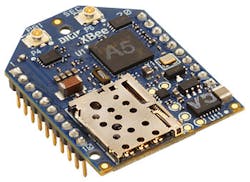New Embedded Smart Modems Bring Cellular Communication to the IoT
Download this article as a .PDF
Enabling Internet of Things (IoT) connectivity is a specialty of Digi International, which was formed in 1985 long before the term “IoT” even existed. Among the company’s products are Digi XBee RF solutions, which support a number of wireless applications. Digi recently made news by expanding its XBee lineup with the introduction of three new cellular modems (see photo).
The new cellular smart modems are the Digi XBee Cellular LTE Cat 1, Digi XBee Cellular LTE-M, and Digi XBee Cellular NB-IoT. According to Digi, the new modems allow original equipment manufacturers (OEMs) to easily integrate cellular connectivity into their devices. Building on the Digi XBee ecosystem, these new products allow the Digi XBee platform to support an even greater number of wireless applications.
Digi XBee Cellular LTE Cat 1 allows OEMs to integrate 4G cellular technology into their devices at a lower price point than previous LTE technologies, according to the company. The Digi XBee Cellular LTE-M and Digi XBee Cellular NB-IoT modems are intended to support the new LTE-M and narrowband-IoT (NB-IoT) technologies, respectively. Both allow for lower costs and extended battery life in IoT applications. Furthermore, Digi XBee Cellular LTE-M is intended for the North American market, while Digi XBee Cellular NB-IoT will find its way into Europe.
Digi XBee Cellular LTE Cat 1 and Digi XBee Cellular LTE-M are both FCC and carrier end-device certified. Thus, OEMs can avoid the cellular certification process. Digi XBee Cellular NB-IoT is CE/RED certified, which makes it ideal for low-power wide-area (LPWA) applications in Europe.
As stated, the new cellular modems allow for easy integration. For example, an OEM may want to design an LPWA device to operate with existing LTE Cat 1 infrastructure. In the future, that OEM could switch to Digi XBee Cellular LTE-M or Digi XBee Cellular NB-IoT with little or no hardware/software redesign.
Performance Features
The new modems have a number of features, chief among them programmability: Local intelligence can be programmed on the modem itself through the MicroPython interface. The modems are also software-upgradeable to allow for Bluetooth Low Energy (BLE) and Bluetooth Mesh connectivity. In addition, users can take advantage of the advanced manageability features offered by the Digi XCTU configuration tool and the Digi Remote Manager, which enables the management and control of devices from a central and secure platform.
All three modems have the same 20-pin through-hole form factor. Furthermore, each achieves a transmit power level of +23 dBm.
Digi XBee Cellular LTE Cat 1, along with its development kit, will be in available in January 2018. Digi XBee Cellular LTE-M and its development kit will be available in February, while the Digi XBee Cellular NB-IoT modem and development kit will be available in April.
Digi International, 11001 Bren Rd. E., Minnetonka, MN 55343; (952) 912-3444, (877) 912-3444


